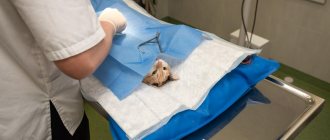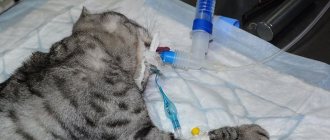Veterinarians advise not to postpone sterilization of a cat indefinitely, since with each passing year the likelihood of postoperative risks increases. The intervention is recommended for all animals not involved in breeding, and is recognized as the most effective prevention of oncology.
Why do you need to sterilize your cat?
After puberty, cats begin to look for a mate. They leave scent marks, scream at night and constantly try to escape from the house. This is a difficult period for every owner. Despite the difficulties that arise, not everyone is in a hurry to resort to surgical intervention, fearing possible risks. Most often, owners resort to an alternative solution - hormonal drugs. They really suppress sexual desire, but with constant use they carry much more risks: the growth of tumors, the development of pathologies of the reproductive system (cyst, pyometra) and urinary systems.
Unlike hormonal drugs, sterilization permanently eliminates sexual desire and reproductive function. It has a beneficial effect on the pet’s condition, protects it from cancer and prolongs its life.
Sterilization methods
There are different methods of sterilization. Not all of them are equally widespread and effective. Preference should be given to the one that the veterinarian who will be performing the procedure best specializes in.
Medication sterilization
To correct behavior, owners often use hormonal drugs that are designed to stop sexual hunting. Veterinarians strongly discourage the use of such medications.
Hormonal drugs do not have the best effect on the general condition of the female’s body. In addition, they only increase the risk of diseases of the reproductive system.
There is another method of medical sterilization, in which a special drug is injected under the skin of the cat. It is slowly dissolving. The effects of one injection can last for three years. This method is used for cats that have breeding value and will be involved in breeding in the future.
After a while, the functioning of the reproductive system is completely restored. This method is also effective if the cat has any contraindications to surgery related to its health condition.
Classic method
The incision is made at a distance of 2-3 cm from the navel along the so-called white line. There are not many blood vessels or nerves, so there is virtually no bleeding after the incision. The uterus is removed through the incision. A ligature is applied to the vessels. Next, the uterus is cut off. Removable or permanent sutures are placed on the skin.
We recommend the article: Why do sores appear on a cat’s face?
Sterilization through a side incision
This method is almost identical to the classic one, only the incision is made from the side. It is believed to be less traumatic and heal faster. However, this method may cause bleeding. In addition, this method is not very convenient for removing the uterus, so it is most often used only for castration - removal of the ovaries.
Laparoscopy
A very expensive method, which is not practiced in all clinics, since it requires special equipment. Two punctures are made on the cat's stomach, into which a camera and a special apparatus are inserted. The main advantage of this method is that the incision is very small, it does not require stitches and heals quickly. However, it is not always possible to completely remove the uterus through such a small incision. Most often, only the ovaries are removed during laparoscopy.
Difference between castration and sterilization
Sterilization (oophorectomy) is tubal ligation with or without removal of the ovaries. Most often, veterinarians perform castration (ovariohysterectomy), which involves removing not only the ovaries, but also the uterus. This method is more effective, as it eliminates the development of tumors and inflammatory diseases in the uterus.
Many people confuse these concepts, separating them not by the specifics of the procedure, but by gender. In everyday life, it is believed that females are sterilized and males are castrated. For convenience, instead of “castration” we will use the more familiar term “sterilization”.
Extirpation of the uterus of a pregnant cat
Sterilization of a pregnant cat is permissible only if there are serious indications. The procedure is called hysterectomy. It is carried out in a standard way - the ovaries and uterus are removed.
If the animal is healthy, veterinarians do not recommend surgery. The longer the period, the higher the risk of complications and the postoperative recovery will be long. Pregnancy for up to 1 month, as a rule, does not cause complications. If the period is more than 1 month, severe blood loss occurs during the operation. The animal takes a long time to recover.
Brief description of the operation
To minimize possible complications, preparatory measures are recommended. They include not only actions immediately before surgery, but also ongoing disease prevention. In particular, this refers to annual vaccination.
Preparing the animal
Anesthesia weakens the immune system, increasing the risk of infection by harmful microorganisms and parasites. For safety, it is recommended to vaccinate your pet at least a month before the procedure. Treatment for helminths is carried out within 1.5-2 weeks. In the absence of timely vaccination, the cat is given a serum injection that stimulates a stable immune response for 2 weeks.
A few days before surgery, a urine and blood test is taken from the tailed patient. To determine the safe dosage of a narcotic substance, the functioning of the heart and respiratory organs is checked using ultrasound and x-rays.
It is recommended to give up feeding 12 hours before, and water 3 hours before. This eliminates the occurrence of vomiting, which provokes the development of aspiration pneumonia.
Choosing a clinic and veterinarian
Pets that don't go outside are afraid to leave their familiar territory. To minimize stress, it is better to choose a clinic closer to home. Walking distance will eliminate travel by transport, reducing the time you spend outside your usual conditions.
For especially timid pets, calling a veterinarian to your home is a good idea. This eliminates the stress caused by a change of environment and the risk of infection from other visitors. The disadvantage of home surgery is the low sterility and lack of equipment necessary to eliminate possible complications. Most clinics provide both types of services, so the choice is up to the owner.
It is ideal if you vaccinate your animal and take it for routine examinations to the same clinic and to the same doctor. A regular veterinarian is familiar with the characteristics of the body.
Progress of the procedure
After anesthesia is administered to the tailed patient, the hair is removed at the site of the future incision or puncture. The procedure itself is carried out in two ways:
- surgical, involving classical excision with a scalpel;
- laparoscopic, based on the creation of small punctures using endoscopic equipment.
In both cases, after making an incision, the surgeon removes the reproductive organs and applies stitches. They are removable and non-removable. The first ones are removed 7-10 days after the procedure, and the second ones resolve on their own.
Preparing for surgery
Before sterilization, the cat must be:
- absolutely healthy;
- vaccinated against infections - vaccinations should be done a month before the expected sterilization.
After anesthesia, cats often feel sick and vomit, so you should not feed the animal 10 hours before surgery, you are only allowed to drink water.
Important! It is better to do the operation during the pause between estrus.
It’s more difficult with older animals: an external examination cannot always reveal hidden ailments, so additional examination will not hurt:
- blood and urine tests;
- heart examination;
- Ultrasound of internal organs (will reveal tumors and cysts that can be removed during sterilization).
Pros and cons of sterilization at different ages
When sterilizing, age plays a primary role. Veterinarians' opinions on the ideal age vary, but the fact that a young body is at lower risk remains the same.
Early (before first heat)
Foreign veterinarians believe that it is better to sterilize a cat when it has not yet reached puberty. This approach guarantees rapid tissue regeneration, reducing postoperative risks. Surgery is performed at 3-6 months.
Opponents of this approach cite possible developmental delays, changes in behavioral characteristics, and the development of pathologies of the eyes, kidneys and endocrine system. There is no consensus here, since supporters of early sterilization have a completely opposite opinion. They are confident that the operated animal grows up healthier.
During puberty
Most veterinarians recommend operating on your pet closer to her first heat, that is, at 7-8 months. Exceptions include kittens of different sexes from the same litter growing up together. They reach puberty earlier, so the date of surgery can be delayed by 4-6 months. Before making a decision, the veterinarian weighs the tailed patient. Its weight should be at least 2.5-3 kg. Otherwise, the operation will be delayed.
In old age
People who have picked up adult animals on the street are constantly wondering at what age a cat can be sterilized. In their case, the chance for early intervention has already been missed, so the issue is resolved individually.
Veterinarians believe that surgery is possible up to 10 years of age. After this age, the pet is considered old, and the likelihood of complications increases to a critical level. Surgery is performed only for special indications that threaten the life of the tailed patient.
Features of sexual development in different breeds
The timing of puberty varies from breed to breed. If your pet begins to show signs of heat too early, check with your veterinarian at what age cats of this breed are sterilized. Representatives of the Siamese-Oriental group mature from 4 months, and large long-haired breeds (Maine Coons, Persians, Siberians) - up to 1 year.
How to care for a cat after sterilization
Few owners have a complete idea of what to do after sterilizing a cat. Meanwhile, it is the postoperative period that determines the further state of the pet’s health.
If it is not possible to leave the cat in the clinic for the first few days, and she is “discharged” home immediately after the operation, you need to learn in detail all the nuances of care from a veterinarian. Depending on the pet’s condition before and after the intervention, she may be prescribed antibacterial drugs, anti-inflammatory drugs or painkillers. In addition, the specialist will tell you when (and whether) you need to come to remove the stitches, how often to do dressings, what products are best to use in this case, and other information. It would be good if the veterinarian can give his phone number so that in case of a sharp deterioration in the condition, he can be contacted without delay.
Features of transporting an animal from the clinic
You need to take your cat home not in your arms, but by placing it in a special carrier that has a flat and even bottom. Any shaking or displacement of the torso can cause the seams to separate. It is advisable to cover the animal with a light blanket or warm cloth, since due to the operation and anesthesia, the pet’s body temperature becomes lower than normal.
Where is the best place to place a cat in an apartment?
While the cat is recovering from sterilization, it is best for her to be on the floor. The owner needs to arrange the bed in advance: choose a spacious place where no one can disturb the animal, lay down a blanket, and put waterproof diapers on top. To ensure free flow of saliva, the pet should be placed on its right side.
It is imperative to ensure that the place reserved for the cat is not in a draft or near a heating device. However, you will still need to cover it; to do this, just take a light but dense fabric.
What to wear on a cat after sterilization
Cat in a blanket after sterilization
After sterilization, the cat's stomach should be isolated from the external environment to avoid infection of the wound. To do this, use a blanket - special clothing with slots for paws, fastened with Velcro or tape on the back of the animal. The device should be worn for about 10-14 days, depending on the complexity of the operation, the condition of the seam and other nuances.
Cat blankets should be washed, ironed, and then put on again. Such clothing is removed only to treat the surgical wound. To prevent your pet from taking it off, there should be no threads or loose ends of ties sticking out on the blanket. The product is selected only according to individual sizes, since the animal will easily remove a wide blanket, while a narrow blanket will interfere with blood flow.
Some owners sew such bandages themselves. Sometimes tights or socks are used as a means of improvisation, having previously cut holes. Whether the cat will wear such a blanket is unknown. Judging by the stories of owners on the Internet, many animals stage concerts or behave aggressively, even without fully recovering from anesthesia. As a result, the blanket is replaced with a collar, and the bandage on the wound is fixed with a plaster.
Coming out of anesthesia
The cat's behavior after surgery becomes inadequate and unpredictable due to anesthesia. During the first 1-2 days, the animal should not be left alone for a long time. Coming out of a narcotic state is accompanied by complete disorientation in space, staggering, wobbly limbs, screaming, meowing, aggression and other manifestations.
The duration of recovery of a cat from anesthesia can range from 5-6 hours to a day or more. But the pet usually begins to come to its senses 2-4 hours after the operation. There is no need to give her anything to drink, much less eat, at this time. It is allowed to moisten the oral cavity with water from a spoon or syringe.
How to feed a cat after sterilization
It is prohibited to feed the cat within 24 hours after sterilization. This is associated with the risk of a gag reflex (due to anesthesia) and decreased intestinal activity. Any contraction of the abdominal muscles or intestinal wall can lead to the opening of the wound or provoke intra-abdominal bleeding. Liquid food in the form of broth, meat ground and mixed with broth, porridge with water can be introduced into the animal’s diet approximately on the second day. You will need to follow a liquid diet until the stitch is removed.
If your cat refuses food and water
The first day after sterilization, the pet may not have an appetite. The alarm should be sounded if the cat does not eat or drink for more than 2 days, and all attempts to give it liquid food or water using a syringe end in failure. To recover, she definitely needs to take at least broth. To prevent dehydration and exhaustion of the pet, the owner should contact the clinic - an alternative may be intravenous nutrition.
Toilet problems
It happens that a cat does not go to the toilet after sterilization. If this happens within 1-2 days after surgery, then there is no need to worry. Due to preoperative fasting and dehydration, she simply has nothing to empty her bowels with. Other reasons for this phenomenon include:
- stress from surgery;
- the effect of anesthesia or drugs;
- the blanket gets in the way;
- the seam hurts.
Lack of bowel movements with normal appetite may indicate constipation. In this case, laxatives and a liquid diet will help. If your cat continues to have problems with the toilet more than 3 days after sterilization, you should immediately consult a veterinarian.
What age is ideal - veterinarians' opinions
Doctors' opinions on what age is best to sterilize cats agree on one thing. Each subsequent year after the onset of estrus reduces the effectiveness of the procedure and increases the likelihood of complications.
The probability of developing oncology in animals operated on before their first heat is only 0.5%. At the time of surgery, the pet must be at least 7-8 months old. The exception is breeds with early maturity or kittens from the same litter.
At what month can a pet be neutered?
Western veterinarians practice early castration of animals - this is between the ages of 8 and 16 weeks. It is believed that this way pets recover more easily, do not have time to form the habit of marking territory, and do not show sexual aggression.
In Russia, animals are castrated not only during puberty, but also at a later age.
It is known that cat breeds differ in the timing of puberty. For example:
- female sphinxes become sexually mature at 4-5 months;
- In Maine Coons, the first heat begins after 9;
- In the Bengal breed, cats begin to mark at 8 months, and girls begin sexual hunting closer to one year.
Estrus, pregnancy and childbirth
Not all owners understand the relationship between the reproductive and reproductive systems. Because of this, it is completely unclear when to spay a cat: before, during or after heat. Even more difficulties arise with the need for childbirth. Many owners mistakenly believe that deprivation of reproductive function is safe only after bearing at least one litter.
Surgery during pregnancy
Surgery is permissible if the pregnancy is no more than 1 month. Otherwise, there is a possibility of increased blood loss and a prolonged postoperative period. Intervention is also permissible in case of abnormal fetal development, poor health or old age, which prevents the safe bearing of kittens. In all other cases, the operation is postponed until complete postpartum recovery.
Surgery after childbirth
After giving birth, a young mother needs 2-3 months to fully recover. During this time, the uterus returns to its original size, and blood circulation in the pelvis is normalized.
Emergency intervention immediately after the birth of kittens is practiced when:
- detection of tumors in the reproductive organs;
- the presence and high probability of postpartum hemorrhage;
- uterine rupture;
- damage or abnormalities of the placenta.
In these situations, the risk of possible complications is higher than the risks associated with sterilization. The procedure is considered justified.
Is it necessary for a cat to give birth at least once before sterilization?
The most popular question arising from the baseless myth about the “joy of motherhood.” From a psychological point of view, animals are not subject to emotions and act instinctively. The absence or presence of pregnancy is taken for granted by them, and therefore does not have a fundamental impact on their lives.
An obvious logic appears when considering the issue from a biological point of view. Before pregnancy, female sex hormones (estrogens), responsible for sexual desire, are produced by the ovaries. If they are removed in a timely manner, the animal loses not only the ability to conceive, but also interest in the opposite sex. Otherwise, other internal secretion organs are involved in the production of estrogen. As a result, the operated pet will not be able to become pregnant again, but will continue its loud rituals of calling cats. If you do not want to endure such concerts for the rest of your furry pet’s life, do not allow mating until sterilization.
In addition to the high risk of retaining some sex hormones, pregnancy reduces the effect of the procedure. The probability of developing cancer after the first birth is 8%, and after the second it increases by more than 3 times.
Is it possible to operate on a cat during heat?
During estrus, hormonal changes occur. Any intervention is fraught with multiple complications, including the development of oncology. Due to the dilation of blood vessels, there is a high probability of heavy blood loss. Animals recover from anesthesia worse and have a more difficult time experiencing the postoperative period.
It is safer to carry out surgery 2 weeks before or after estrus, when the pet’s condition returns to normal. Exceptions include prolonged heats with a short interval between them. They impair quality of life and lead to exhaustion. In this case, the animal is sterilized for medicinal purposes.
About prices
In large cities such as Moscow, St. Petersburg, Tyumen there is a choice of veterinary clinics.
Prices for services vary. Even in small towns, the range of services can be economy class or as complete as possible. It usually includes:
- preliminary examination of the animal;
- laboratory research;
- anesthesia;
- surgical procedures;
- Consumables;
- necessary additional examinations;
- monitoring the animal during the postoperative period, etc.
Indications and contraindications
There are always exceptions to general rules. In some cases, surgical intervention is permissible even if there are contraindications.
When should an animal not be sterilized?
It is prohibited to sterilize an animal that has not been vaccinated or previously treated against parasites. Other possible contraindications include:
- old age (more than 10 years);
- pathologies of the cardiovascular system and respiratory organs;
- acute viral infections and chronic lesions of the genitourinary system;
- estrus, pregnancy and the postpartum period, including lactation.
Neglecting the listed contraindications is permissible in case of a serious threat to life. If other methods to prevent dangerous complications do not help, the pet is sterilized.
When is surgery necessary?
Emergency surgery is rarely performed. It is prescribed when it is detected:
- abnormalities associated with pregnancy;
- malignant neoplasms in the reproductive organs and mammary glands;
- false pregnancy.
It happens that with incomplete removal of the ovaries, repeated estrus appears. To eliminate the consequences of unsuccessful sterilization, the animal is operated on again.
When can you not operate?
If the furry is very small, then the procedure is life-threatening.
- At the age of 0-4 months. Due to its small age, there is a risk that the kitten will not recover from anesthesia. The animal will lag behind in development and growth.
- During heat. It is better to carry out the procedure 14 days before estrus or the same amount after estrus, otherwise there is a high risk of blood loss.
- After 6 weeks of pregnancy.
- Lactation period. If the cat has lambed, you need to wait until the pet feeds the kittens (about 8 weeks after the birth).
Consequences
The consequences of a cat sterilization operation depend on how many months the procedure was performed. If the manipulation was performed before the onset of puberty, when the internal organs of the animal are not yet fully formed, the risk of further inflammatory diseases of the urinary tract and the formation of stones is increased.
It has been noted that Scottish Fold cats require a special diet. If fed improperly, animals quickly gain weight. Obesity in Scottish cats often causes problems with the cardiovascular and respiratory systems. These pathologies can negatively affect the life expectancy of the animal.
All information posted on the site is provided in accordance with the User Agreement and is not a direct instruction to action. We strongly recommend that before using any product, you must obtain a face-to-face consultation at an accredited veterinary clinic.
When is a Scottish cat neutered?
Veterinarians give clear advice at what age to castrate Scottish kittens - as soon as possible after birth, approximately 10-12 months. This is the optimal age for the operation, when the animal is considered sexually mature, hormones in the body have played a role in development, so there are no contraindications to castration of a Scottish fold cat. The main thing is that the cat is healthy and is examined by a veterinarian.
If a cat is neutered after the experience of mating with a cat, then he may retain the mating process, as well as intuitive memory and behavior.
A Scotsman can and should be castrated at any age, but preferably before the age of 5, when he does not have age-related diseases.
The cost of castration surgery varies depending on the region of the Russian Federation, as well as where it is performed. Calling a veterinarian to your home is convenient for the owner and the cat, but is complicated by special preparations for the site for surgical procedures.
Table No. 1 Approximate cost of castration of cats in different cities of the Russian Federation.
Why do they castrate?
Many people choose a Scottish fold or straight-eared kitten for the soul, because of their love for this breed of cat. Often, breeders themselves neuter pet-class kittens with slight deviations from the standard before sale. This is especially true for Scottish Folds, who are susceptible to genetic diseases due to improper mating.
Unsterilized cats, in the absence of mating, mark the space with stinking urine, during sexual behavior they loudly make terrible sounds and show aggression, which forces the owner to resort to castration surgery.
A conventional operation (orchiectomy), when the testicle in the scrotum needs to be removed, goes quickly. It only takes 15 minutes for the veterinarian to make one small incision, remove the testes, and return the pet to the owner.
Minor complications can arise when you need to castrate, and the kitten is diagnosed with cryptorchidism:
- the ovary-testis is not descended into the scrotum:
- the ovary-testis is located outside the scrotum;
- the ovary-testis is incorrectly located, under the skin in the groin or perineum.
In case of such deviations, the “cryptorchus” operation can be performed in the following ways:
The open method requires surgical intervention with an incision in the place where the ovary-testis is found:
- A more gentle intervention using a puncture, through which the doctor performs all manipulations to remove the ovary and testis.
- Scottish cats should not be fed 5 hours before the operation, because it is performed under anesthesia, and the animal may vomit.
Pet after castration
The entire postoperative period for both straight-eared and fold-eared kittens will last several days and pass without complications. The Scottish cat will need special care on the first day when he recovers from anesthesia:
- be sure to place a sanitary napkin under it; if it is weakened, it may not reach the tray;
- provide a warm place; after surgery, the cat’s internal heat exchange is disrupted;
- Do not place the cat in high places so that it does not fall;
- do not force him to eat, but place him next to a container of water.
After recovering from anesthesia, a well-rested pet will behave as usual. It is important to make sure that he does not lick the incision site. To do this, a postoperative collar is put on him. The wound is treated with an antiseptic for several days.
How to provide your cat with sexual peace without health problems
An alternative to the previous two options is to spay or neuter your Scottish cat. There are no differences in the above-mentioned operations for fold-eared and straight-eared cats.
Spaying or oophorectomy involves removing a cat's ovaries. Castration, otherwise known as ovariohysterectomy, is the removal of both the ovaries and uterus of an animal.
Today, the opinion has taken root that sterilization is an operation to remove the genital organs of a cat, and castration is an operation for cats. But that's not true. A cat can be both spayed and sterilized. Since sterilization cuts off the cat’s desire to mate, but does not prevent the risk of developing sexual diseases (inflammation, tumors or cancer), it is often preferred to perform cat castration operations.
Further in the article, for ease of perception, the castration procedure will be mentioned and described, which implies the removal of both the ovaries and the uterus, with the familiar name “sterilization”.
There is also an option that involves tubal ligation, but this is one of the most inhumane options, because the cat will show desire, but will not be able to give birth. The layering of hormones will lead to life-threatening diseases. The same applies to hormonal therapy: taking pills will only suppress the cat’s desire, but will not solve subsequent health issues.
Many believe that it is generally not worth making any interventions in the sexual life of cats, because it is inhumane. However, a counter question immediately arises: how humane is it to leave kittens born to a cat on the street or drown them in a lake? How humane is it to hear how an animal suffers several times a year when it comes into heat and do nothing about it? Cats' desire is so strong that sometimes they completely refuse food and even water and simply scream for several days! The pet will not be able to think about anything other than its impatience. And the consequence of such numerous phenomena will certainly be health problems, manifested at least by inflammation of the genital organs or mammary glands. But disturbances in the functioning of the reproductive system can be much worse and include tumors and even cancer of the mammary glands, uterus or ovaries!
▲ to contents











